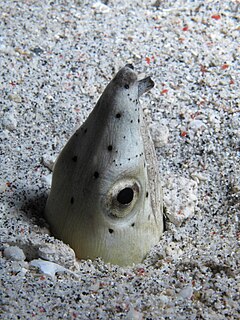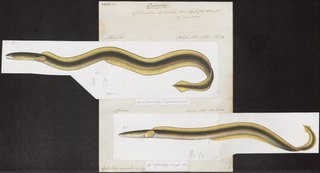
Ophichthus is a genus of eels in the snake eel family Ophichthidae.

The highfin snake eel (Ophichthus altipennis, also known as the blackfin snake eel or the black-finned snake eel, is an eel in the family Ophichthidae. It was described by Johann Jakob Kaup in 1856, originally under the genus Microdonophis. It is a marine, tropical eel known from the eastern Indian Ocean and northwestern and western central Pacific Ocean, including Australia, French Polynesia, Indonesia, Japan, the Marshall Islands, Malaysia, the Philippines, and Papua New Guinea. It dwells at a depth range of 0 to 40 m, and forms burrows in soft inshore sand sediments. Males can reach a maximum total length of 103 cm.

The bluntnose snake-eel is an eel in the family Ophichthidae. The author of the species is anonymous, but it has been referred to Edward Turner Bennett in 1830. It is a tropical, marine eel which is known from the Indo-Pacific, including Kenya, Madagascar, South Africa, Taiwan, Thailand, and the Philippines. It dwells at a maximum depth of 22 m, but also frequents shores. Males can reach a maximum total length of 45 cm.

The Napoleon snake eel is an eel in the family Ophichthidae. It was described by Johann Jakob Kaup in 1856, originally under the genus Poecilocephalus. It is a marine, tropical eel which is known from the Indo-Pacific, including Durban, South Africa, Mauritius, Indonesia, Japan, Australia, and the Penghu Islands. It is known to dwell at a depth of 20 metres (66 ft), and inhabits lagoons and reefs; it forms solitary burrows in sand sediments. Males can reach a maximum total length of 75 centimetres (30 in).

The dark-shouldered snake eel is an eel in the family Ophichthidae. It was described by Pieter Bleeker in 1864. It is a tropical, marine eel which is known from the Pacific Ocean, including the East Indies, the Society Islands, the Mariana Islands, Queensland, the Marshall Islands, Micronesia, Japan, and India. It dwells at a depth range of 2–15 metres, and inhabits reefs. It forms burrows in mud and sand, and forages during the night. Males can reach a maximum total length of 115 centimetres.
The dusky snake eel is an eel in the family Ophichthidae. It was described by Camillo Ranzani in 1839. It is a tropical, marine eel which is known from the western Atlantic Ocean, including Cuba and Brazil.
The death-banded snake-eel is an eel in the family Ophichthidae. It was described by Samuel Garman in 1899. It is a tropical, marine eel which is known from the eastern central and southeastern Pacific Ocean, including the central Gulf of California, Colombia, Costa Rica, Mexico and Panama. It dwells at a depth range of 35–760 metres, and forms burrows in sandy and muddy bottoms. Males can reach a maximum total length of 86 centimetres.
The faintsaddled snake eel is an eel in the family Ophichthidae. It was described by John E. McCosker and Eugenia Brandt Böhlke in 1984. It is a marine, temperate water-dwelling eel which is known from the western central Atlantic Ocean. It is known to dwell at a depth of 108 meters.

The Evermann's snake eel is an eel in the family Ophichthidae. It was described by David Starr Jordan and Robert Earl Richardson in 1908. It is a marine, tropical eel which is known from the western Pacific Ocean. It inhabits inshore soft bottoms.
The bigfin snake eel is an eel in the family Ophichthidae. It was described by Pieter Bleeker in 1853. It is a tropical, marine eel which is known from the Indo-Pacific. It dwells at a depth range of 0–25 metres, and inhabits sand and mud. Males can reach a maximum total length of 92 centimetres.
The shorthead snake-eel is an eel in the family Ophichthidae. It was described by Wilhelm Peters in 1855, originally under the genus Ophiurus. It is a marine, tropical eel which is known from the western Indian Ocean, including Aldabra and Mozambique. Its range was once reported to include Knysna, South Africa, but the specimen on which this claim was based has disappeared. Males can reach a maximum total length of 47 centimetres (19 in).
The dottedline snake eel is a species of eels in the family Ophichthidae. It was described by John E. McCosker and Eugenia Brandt Böhlke in 1984. It is a marine, temperate water-dwelling eel which is known from the western central Atlantic Ocean. It is known to dwell at a depth of 183 meters.

The many-eyed snake-eel is a species of eel in the family Ophichthidae. It was described by Pieter Bleeker in 1864. It is a tropical, marine and freshwater-dwelling eel which is known from the Indo-Pacific, including East Africa and the Hawaiian Islands. It dwells at a depth of 2 to 25 metres, and inhabits sand and rubble sediments near coral reefs. Males can reach a total length of 62.5 centimetres (24.6 in).

The punctuated snake-eel is an eel in the family Ophichthidae. It was described by Achille Valenciennes in 1837, originally under the genus Ophisurus. It is a marine, subtropical eel which is known from the eastern central and southeastern Pacific Ocean, including Nicaragua, Chile, Colombia, Costa Rica, Ecuador, Peru, and Panama. It dwells at a depth range of 15 to 277 metres, and inhabits sand and mud sediments. Males can reach a maximum total length of 85 centimetres (33 in), but more commonly reach a TL of 60 centimetres (24 in).
The rufus snake-eel is an eel in the family Ophichthidae. It was described by Constantine Samuel Rafinesque in 1810, originally under the genus Echelus. It is a marine, subtropical eel which is known from throughout the Mediterranean and the Black Sea, in the northeastern Atlantic Ocean, including Algeria, Albania, Croatia, Egypt, France, Cyprus, Gibraltar, Greece, Italy, Israel, Montenegro, Lebanon, Libya, Malta, Morocco, Monaco, Slovenia, Spain, Tunisia, the Syrian Arab Republic, and Turkey. It inhabits mud sediments on the continental shelf. Males can reach a maximum total length of 60 centimetres (24 in).
The olive snake eel is an eel in the family Ophichthidae. It was described by Pieter Bleeker in 1853, originally under the genus Ophisurus. It is a marine, tropical eel which is known from the Indo-Pacific. It forms burrows in soft sediments in shallow waters, and leads a nocturnal lifestyle. Males can reach a maximum total length of 95 centimetres (37 in).
The Antillian snake eel is an eel in the family Ophichthidae. It was described by John Roxborough Norman in 1922. It is a marine, deep water-dwelling eel which is known from the western central Atlantic Ocean, including Cuba, Puerto Rico, Trinidad-Tobago, and Venezuela. It is known to dwell at a maximum depth of 300 meters, and inhabits coastal waters. Males can reach a maximum total length of 107 centimeters, but more commonly reach a TL of 70 cm.

The Pacific snake-eel is an eel in the family Ophichthidae. It was described by Johann Jakob Kaup in 1856, originally under the genus Muraenopsis. It is a marine, subtropical eel which is known from the eastern central and southeastern Pacific Ocean, including California, USA, Peru, the Gulf of California, Mexico, the Galapagos Islands, Colombia, Ecuador, Costa Rica, El Salvador, Honduras, Guatemala, Nicaragua, and Panama. It dwells at a maximum depth of 155 metres (509 ft), and forms burrows in mud and sand sediments. Males can reach a maximum total length of 115 centimetres (45 in), but more commonly reach a TL of 80 centimetres (31 in).
The plain snake-eel is an eel in the family Ophichthidae. It was described by Charles Tate Regan in 1908. It is a marine, subtropical eel which is known from Algoa Bay, South Africa, in the southeastern Atlantic Ocean. Males can reach a maximum total length of 30 centimetres (12 in).

The manetail snake eel is an eel in the family Ophichthidae. It was described by Coenraad Jacob Temminck and Hermann Schlegel in 1846, originally under the genus Conger. It is a marine, tropical eel which is known from the Indo-Pacific. It inhabits deep waters, but is found in muddy sediments in shallow waters on rare occasions. Males can reach a maximum total length of 61.5 centimetres (24.2 in).







